Background
Hello and welcome to the trip report on my shortest ever flight!
During a wonderful 2 weeks of travelling around the Yucatan, I decided to splurge and opt for the aerial route between the mainland and island paradise of Cozumel. 99% of visitors will take the frequent and economical ferries from Playa del Carmen, combining these with straightforward and practical road connections to the main tourist hub that is Cancun. The only other alternative for independent travellers is MAYAir's service into Cozumel's small and practical airport, which operate 3-4 times a day. These obviously come at a premium when compared the road + ferry option, but can be found for as little as $60 roundtrip if the airline is running a promotion. Needing to leave a rental car at Cancun Airport anyway, I found a one-way ticket on Skyscanner for $40 and took the plunge.
Opting for the 13:00 departure, this allowed for a leisurely morning journey from Valldolid and arrival onto the island at least 2-3 hours before the ferry would. The real clincher in choosing the flight over the ferry came in the form of MAYAir's choice of equipment on this route - the tiny and elusive Dornier 228 turboprop. As a bonus, the scenery when flying between these two white-sand destinations is meant to be spectacular. All in all, it didn't require much selling.
Cancun Inter-Terminal transfers
MAYAir differs from the vast majority of airlines flying from Cancun in that it does not use one of the main terminals (1-3), but rather the small general aviation terminal known as the FBO, or sometimes confusingly also as Terminal 4. Arriving from Cancun aboard the ADO airport shuttle, the signage appeared to suggest that the shuttle drops passengers at every terminal including the FBO. I was bluntly informed this was not the case by the driver when we pulled into Terminal 3 and all remaining passengers were instructed to disembark.
Luckily I'd done enough research to confirm that the free intra-terminal shuttles buses do connect all 4 terminals, although their frequency can stretch to as much as every 20-25 minutes. Not ideal for short transfers. Finding the shuttle stop at Terminal 3, it became clear that the FBO is only connected by this service to Terminal 2, and any other terminals require a connection or making your own way to Terminal 2. With about an hour left before my flight, what felt like plenty of time a minute ago now seemed like a logistical mountain to climb. Confused foreigners at a bus stop are obviously easy prey for the swarms of taxi drivers - I was consistently quoted an insane $17 fare for the 3-minute drive! The drivers' attitudes were horrendous, and despite speaking Spanish fluently I was still bombarded with claims that the FBO is "many kilometres away" or that I might as well go home if I want to reach the FBO by myself.
But sure enough, if a taxi driver says something is impossible it likely isn't. Google Maps showed Terminal 2 as an 8-minute walk away, which took me along some unconventional access roads but had me at the correct bus stop in no time. Admittedly, this was a warm walk in January and would be much less appealing in the peak summer months. Within minutes, a nondescript minivan pulled up to the bus stop with 'FBO/T2' on a plaque in the windscreen. My only other company in the van were some confused airport staff who triple-checked I knew where I was going! Clearly this isn't the conventional way that passengers reach the FBO, but I can confirm it works.
Cancun FBO (aka terminal 4)
The FBO is a small but very modern terminal that serves mostly private aircraft, as well as the operations of MAYAir and Tropic Air. Both operate very small fleets of very small planes, so the demands on the terminal are minimal.
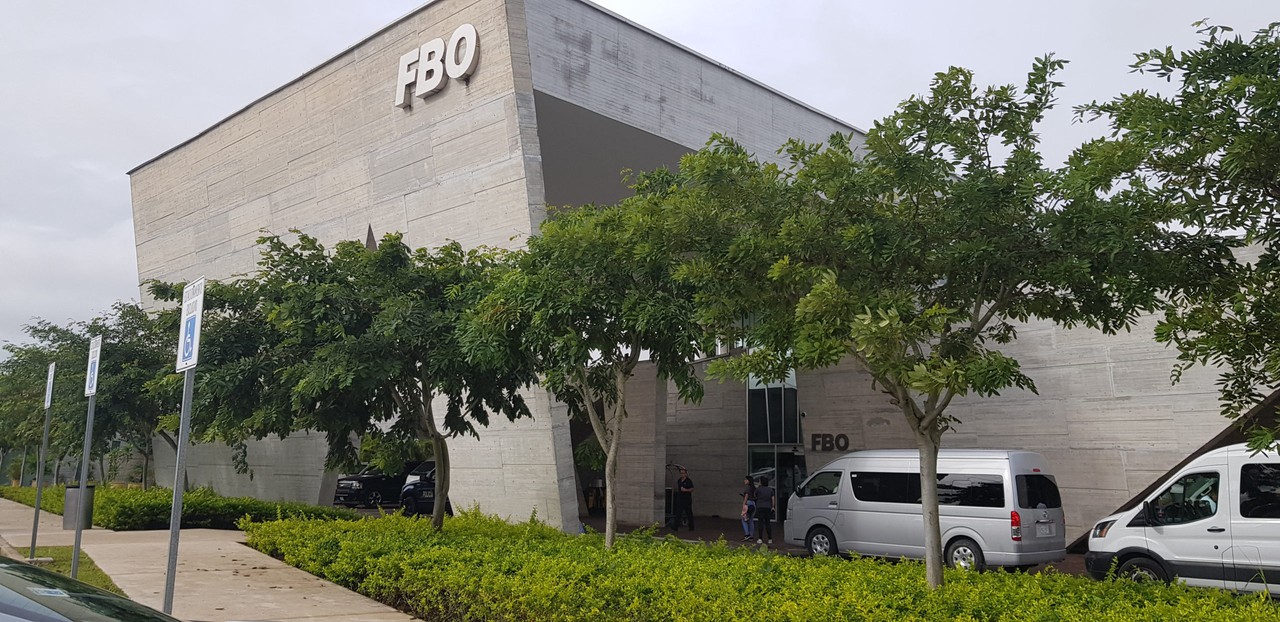
Likewise, the facilities in the FBO are minimal. Aside from two manual check-in desks for the regional airlines and a solitary security checkpoint at the far end, there is nothing else but some seating in the commercial side of the terminal. Don't plan on grabbing a coffee or snack here - in fact, there is precious little benefit to arriving more than 20-30 minutes before your flight!
I checked my one free piece of baggage in and sat down while the agent processed my boarding pass. My flight was a relatively full one, but due to the tiny aircraft size this doesn't exactly translate to a crowded terminal. Passenger's checked baggage was manually moved from the check-in desk to the security checkpoint where it would go to be loaded onto the plane - no conveyor belts here.

The security checkpoint soon opened for all passengers on our flight and was no different to that of any other airport. The holding area on the other side was only a few square yards, so it makes sense for ground staff to leave security till as late as possible. I found myself in first place next to the door out to the tarmac, which is great as MAYAir operates an open seating policy on their flights. Regardless, each passenger did have a seat assignment on their boarding pass, causing a little confusion as many allocations simply didn't exist on the Dornier.
At 12:58, we were led by ground staff outside and across to our waiting aircraft.
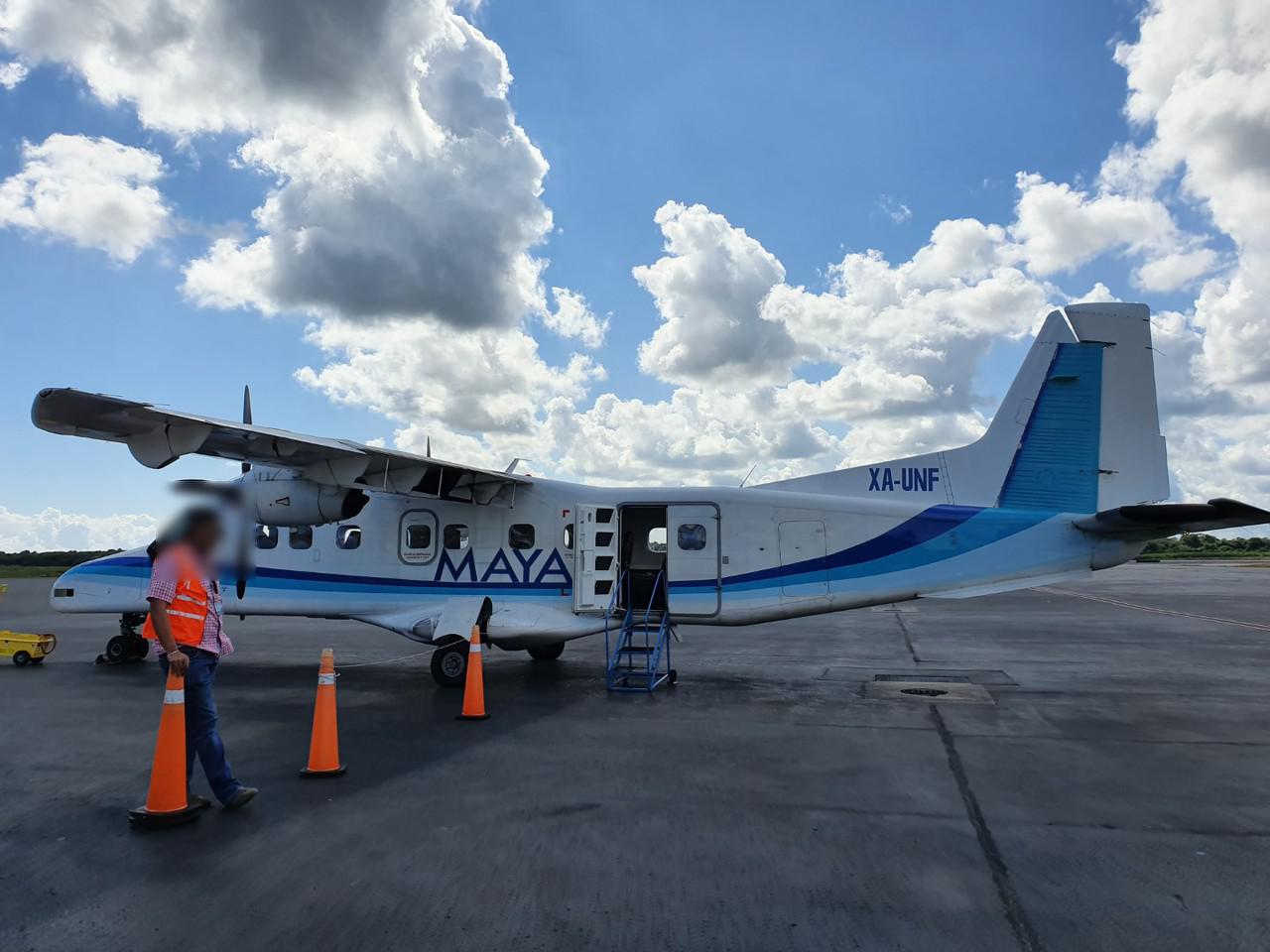
Mayair flight 14
Today's ride would be XA-UNF, one of three Dornier 228's in their fleet at the time. This particular bird first flew in late 1997, hopping around the Caribbean for most of its life with the likes of Air Guadelupe and Air Caraibes, joining MAYAir in 2013. With just 19 seats in an all-economy 1-1 configuration, this would be by far the smallest commercial aircraft I'd flown.
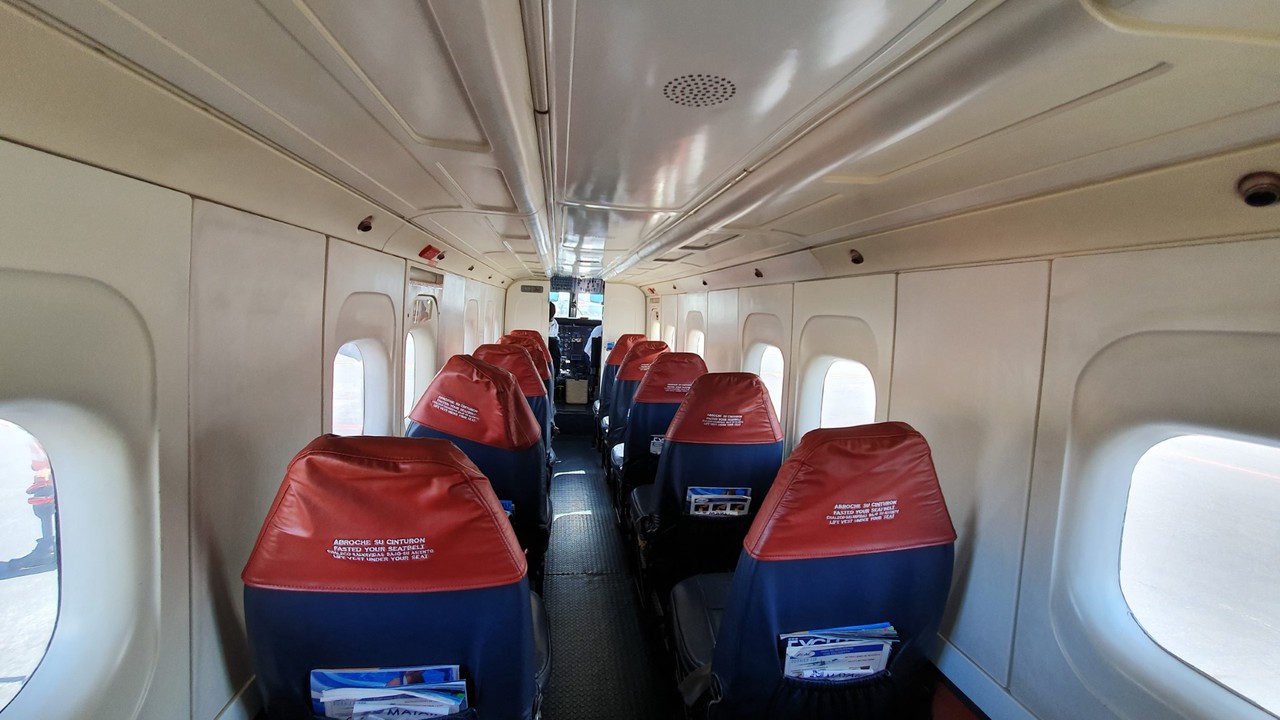
I made a beeline for the coveted seats in row 1, directly behind the doorless cockpit. The only crew on this flight were the two pilots, who I greeted upon entering and asked which side they'd advise sitting on for the best views. The FO recommended the right hand side, so I took my seat in what would be 1C (were the rows actually numbered!)

No points for extra bulkhead legroom or storage space, but who cares with this view!?
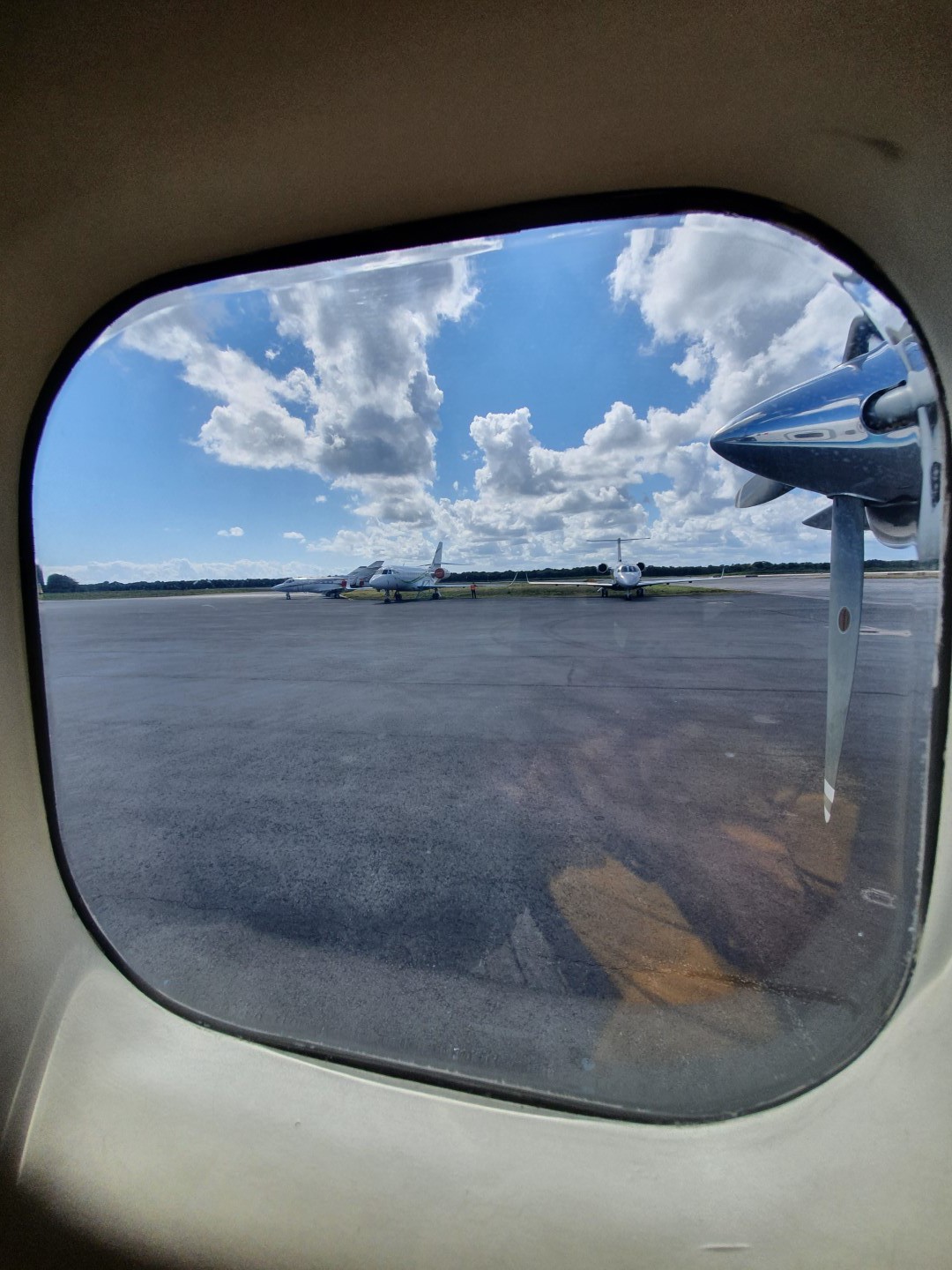
I loved the Do-228's slightly bubbled windows, and the first row gives excellent prop/wing views as well as those through the cockpit.
The crew (captain and first officer, no cabin crew on these aircraft) gave a brief introduction and run through the safety procedures before firing up each of the turboprop engines as the ground staff vacated.
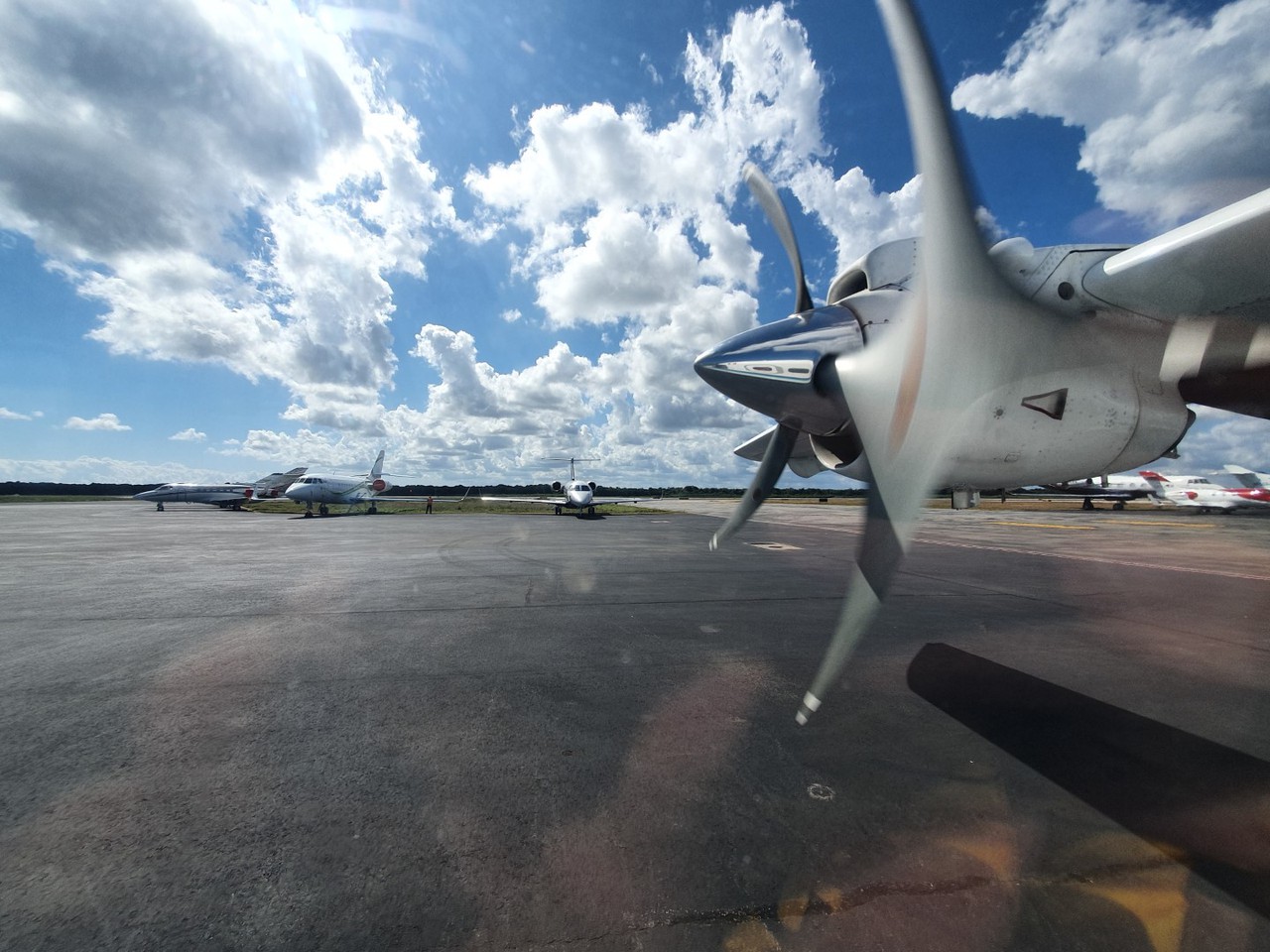
Fortunately for us, the FBO is located very close to the threshold of runway 30L, which was being used as today's arrivals runway. The taxi involved passing a lot of private jets and small aircraft, likely belonging to the rich and powerful currently frequenting the Riviera Maya for their holidays.

The taxi also involved passing parallel to Terminal 3, from which I'd take my Air Transat A330 out of Mexico just over a week later. It seems to be the terminal of choice for most US and Canadian airlines, judging by the UA 777, AA 787 and fleet of DL 737s waiting in the midday heat. It's humbling to think that less than 2 months later, these airlines will all but have vanished from Cancun and this enormous tourism hub would be reduced to a ghost airport.

But blissfully unaware of the impending global crisis, our flight continued to the runway threshold where we held for a TS A330 and AA 737 to land. Fortunately, the other seat in row 1 was one of the few that stayed empty, allowing great views of the approaching heavies from our miniscule prop!
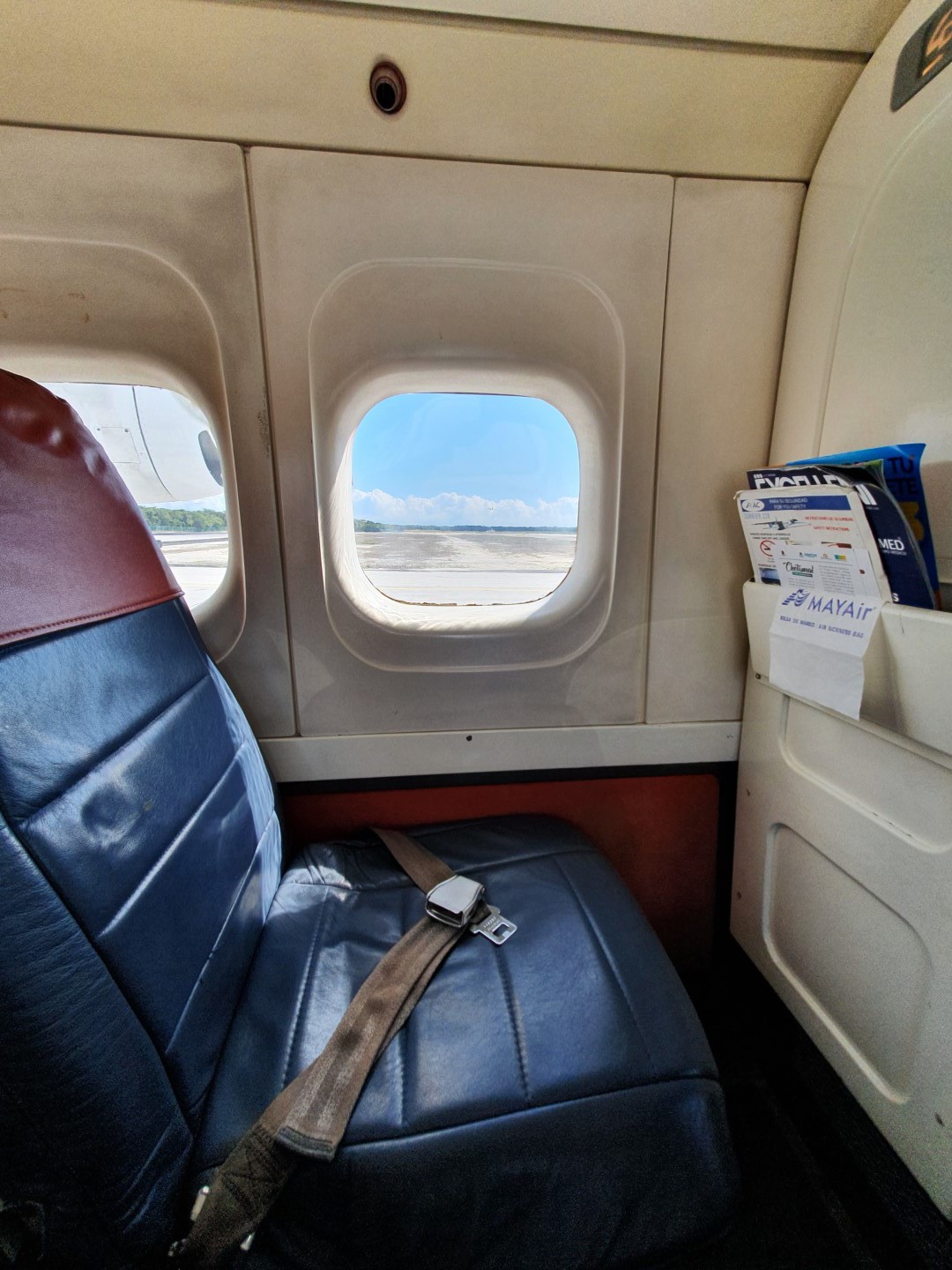
No overhead storage? No problem.
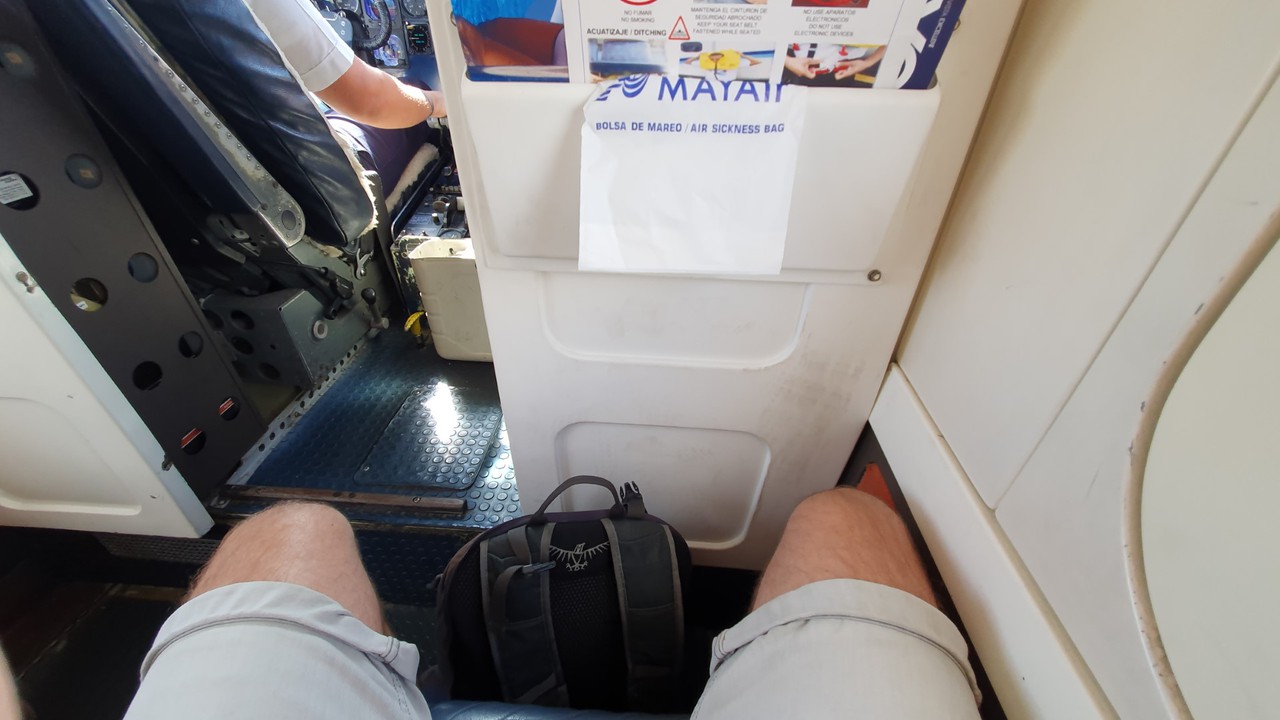
At 13:13 it was our turn to enter 30L, where we made a rolling start to an understandably short take off roll. The crew made full use of the Do 228's STOL capabilities and we shot off the runway not even halfway down.
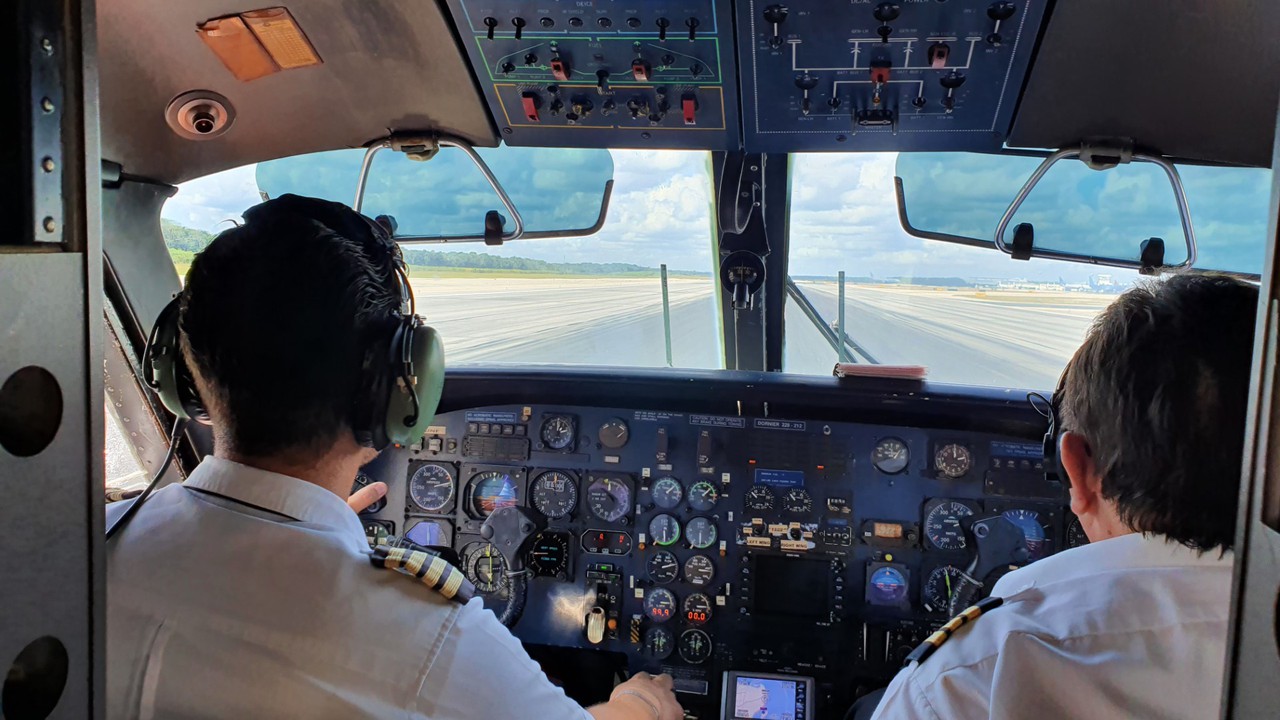
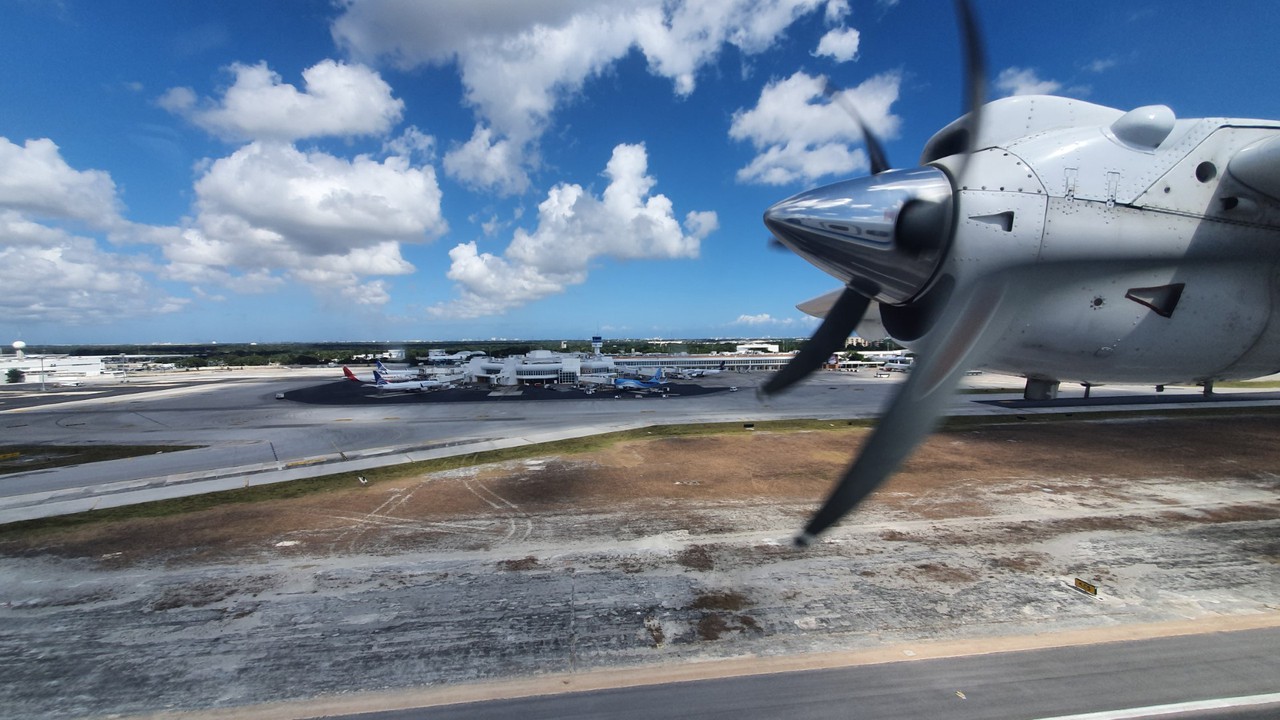
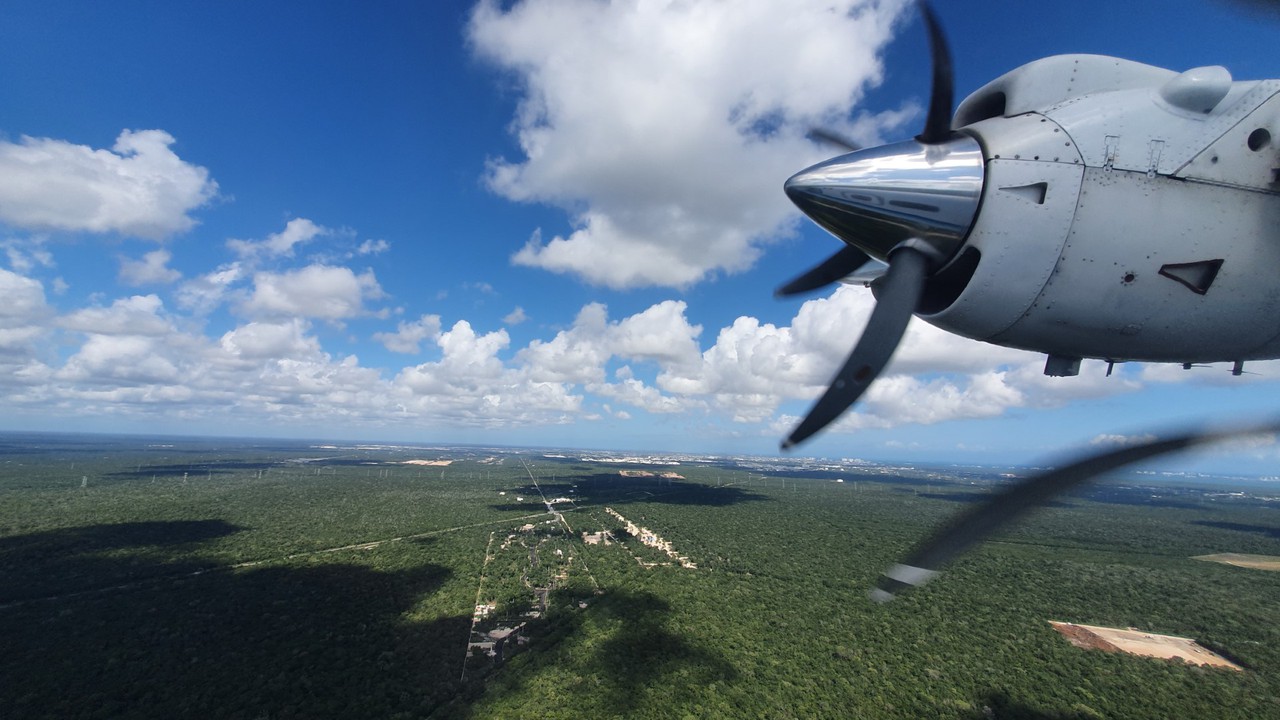
I was torn with which way to look, as Quintana Roo's dense green jungle sprawled out the window but the pilot's-eye view from the cockpit being right ahead too!

We levelled out almost immediately at 1,500ft for the duration of this hop. Turning southeast from CUN, we spend a few more minutes above the Yucatan's pancake-like terrain before approaching the golden shores of the Riviera Maya.
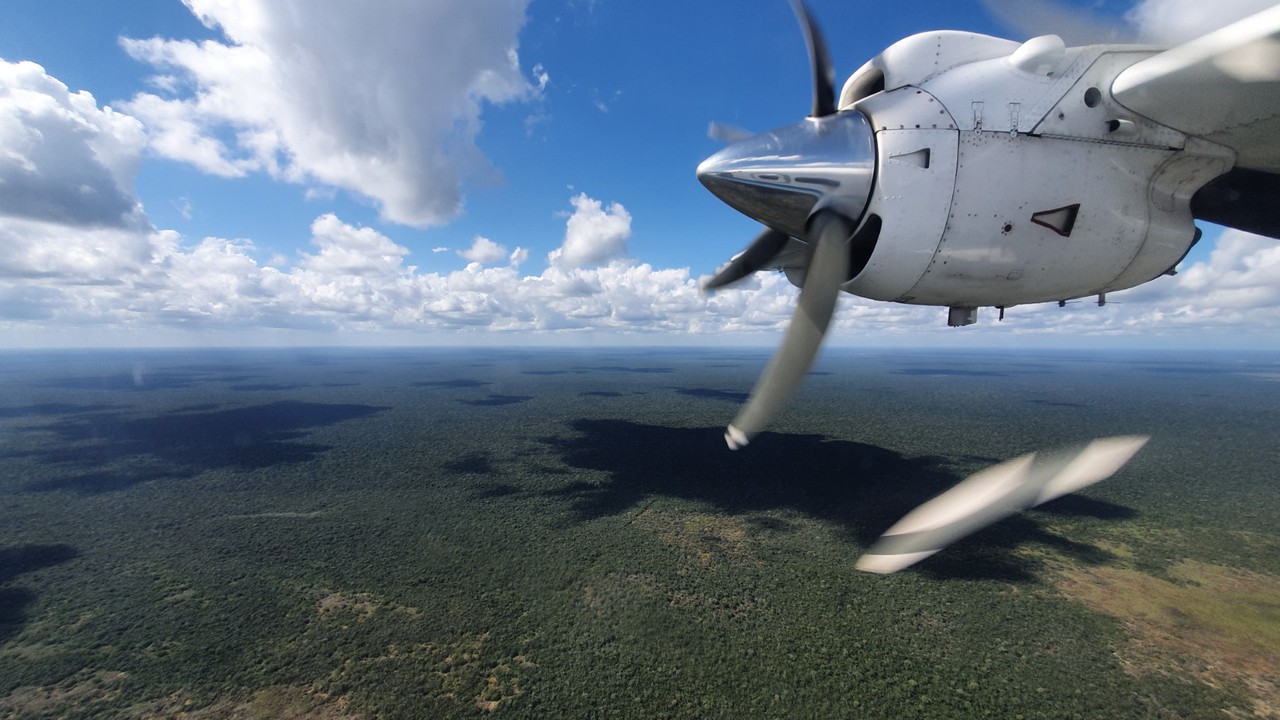
I couldn't pinpoint where exactly we crossed the coast, but it was certainly south of the major beachside developments near Cancun.
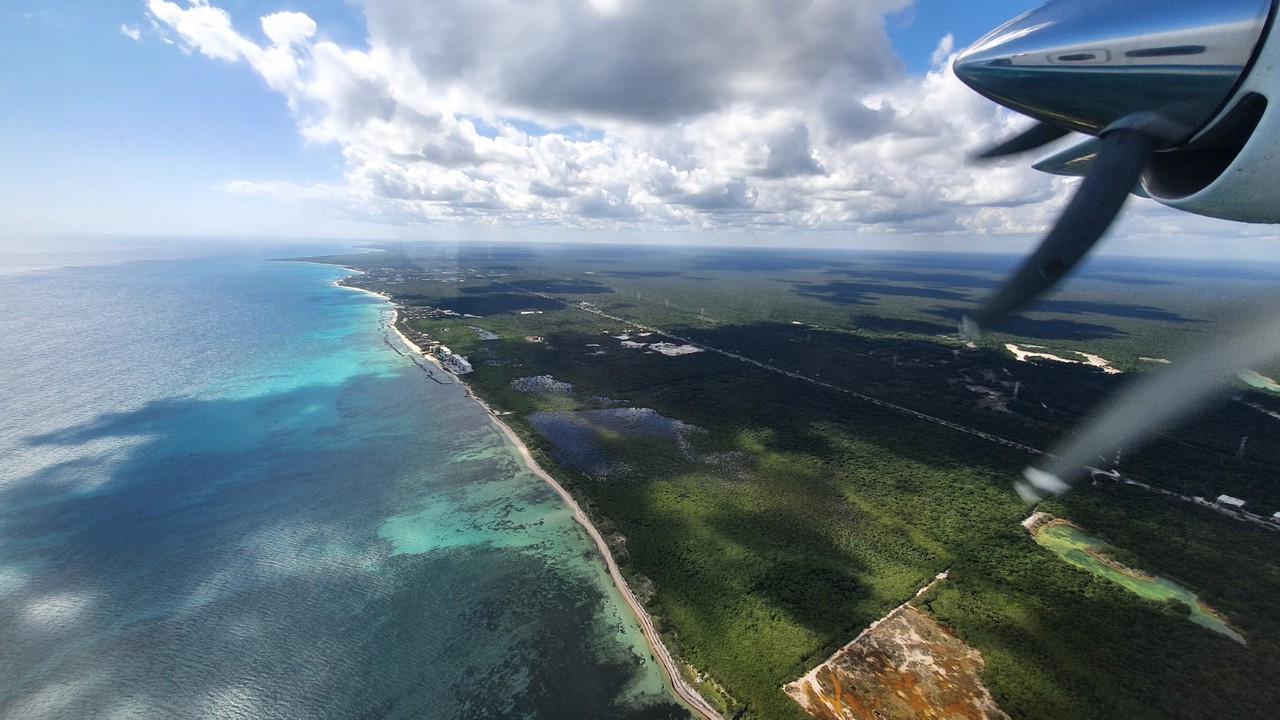
As promised, the views this route is known for became immediately apparent as the crystal-clear turquoise waters of the Caribbean rolled underneath us.
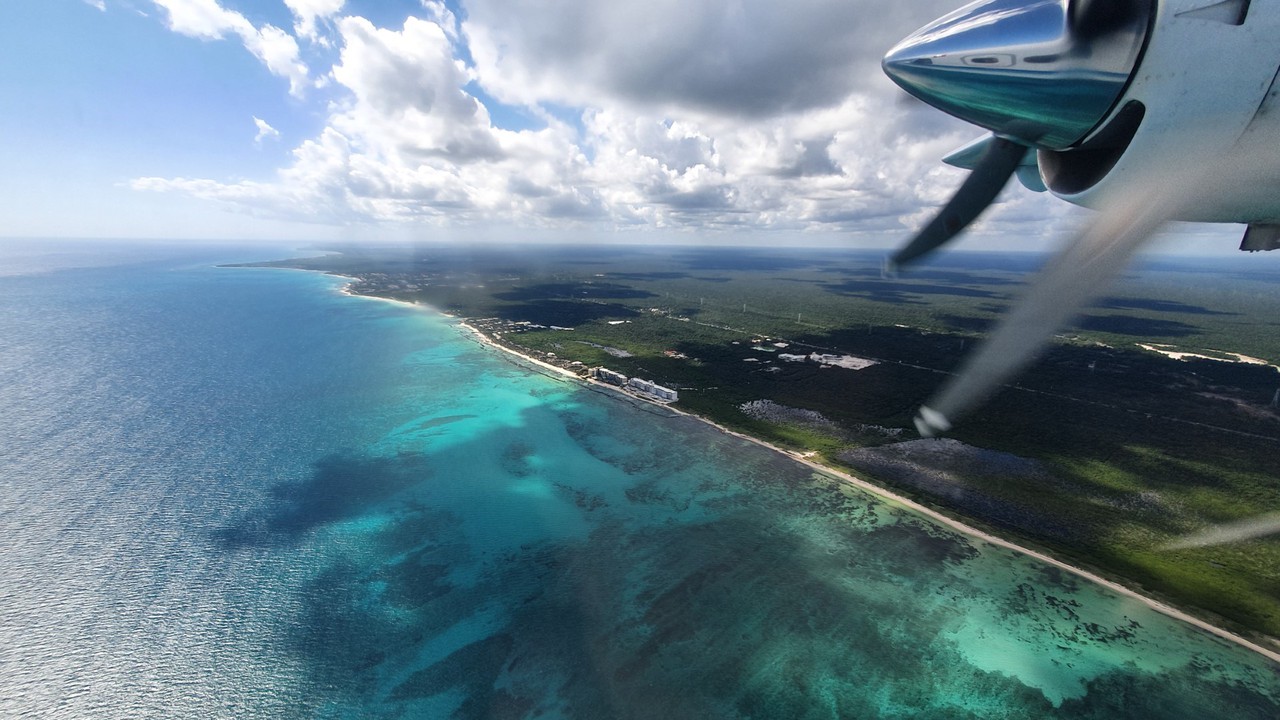
The water's clarity gave a beautiful bird's eye view of the coral and underwater reef formations that make this part of the world such a hotspot for underwater enthusiasts. After all, I was heading to Cozumel for scuba diving first and foremost!
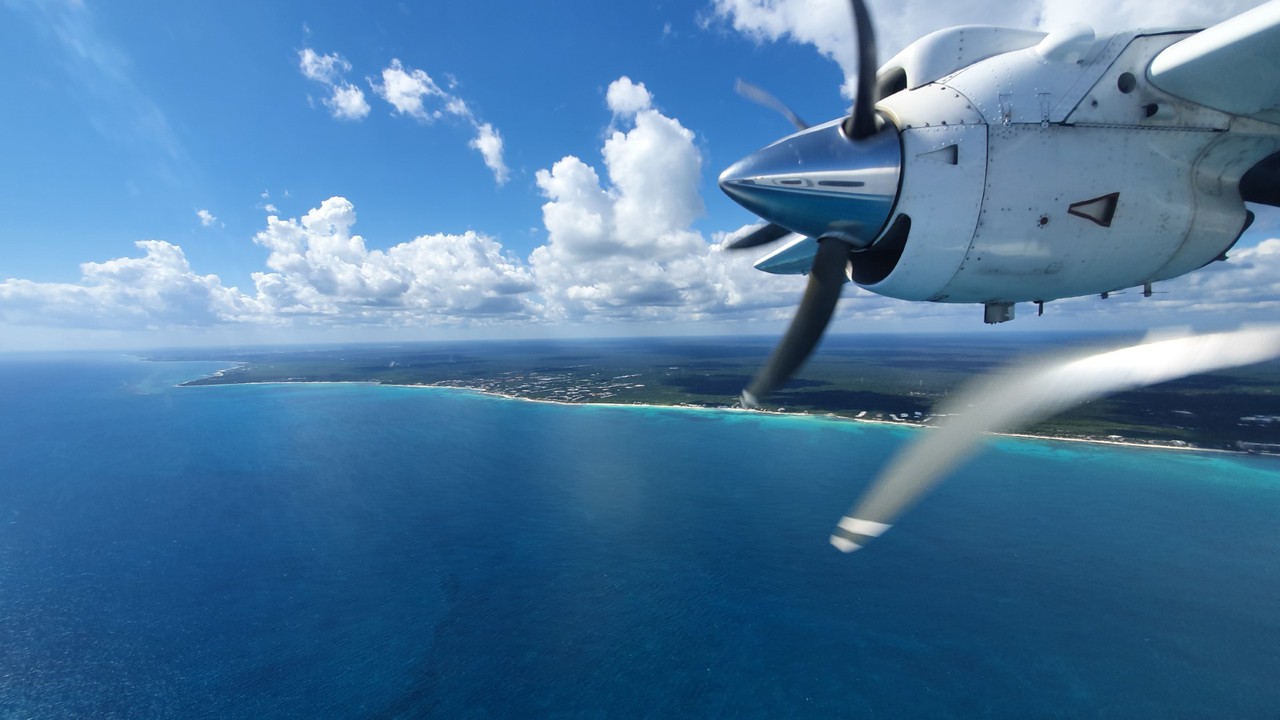
The azure waters gave way to deeper blues as we left the coast behind and honed in on Cozumel. The Do 228 was certainly loud, even compared to other turboprops such as ATRs and Dash-8s but on a flight as short as this, I don't think anyone on board was fussed.

Cozumel's undeveloped northern coast came into view just 10 minutes after our wheels left CUN. With it, the water once again went from navy to a dazzling fluorescent blue and the captain's recommendation to sit on this side of the aircraft started to make sense.
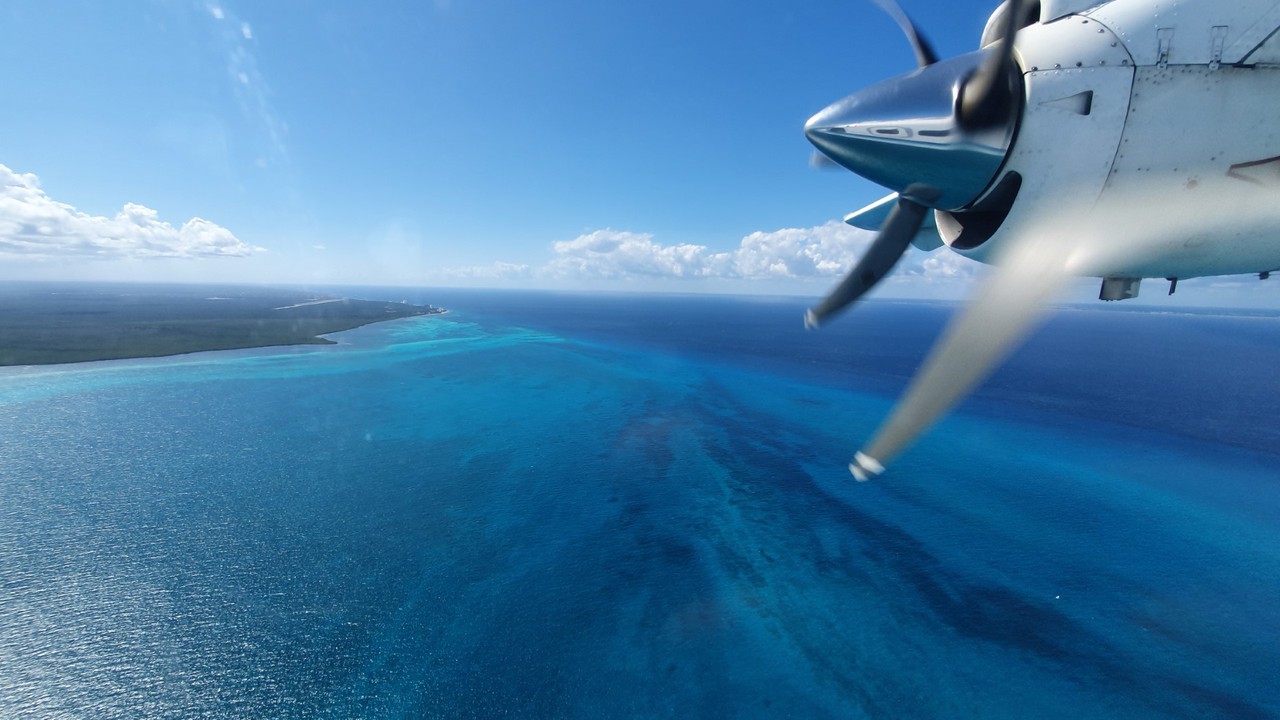
From here Cozumel's two runways also came into view, as the airport is essentially the only major development in the northern 1/3 of the island. But the sights directly below soon took everyone on board's attention instead.

The combination of midday sun, nonexistent wind and a glorious approach path culminated in some of the most beautiful views I'd ever seen out an airplane window, as the huge expanse of coral reef gleamed under electric blue waters straight off a magazine cover.

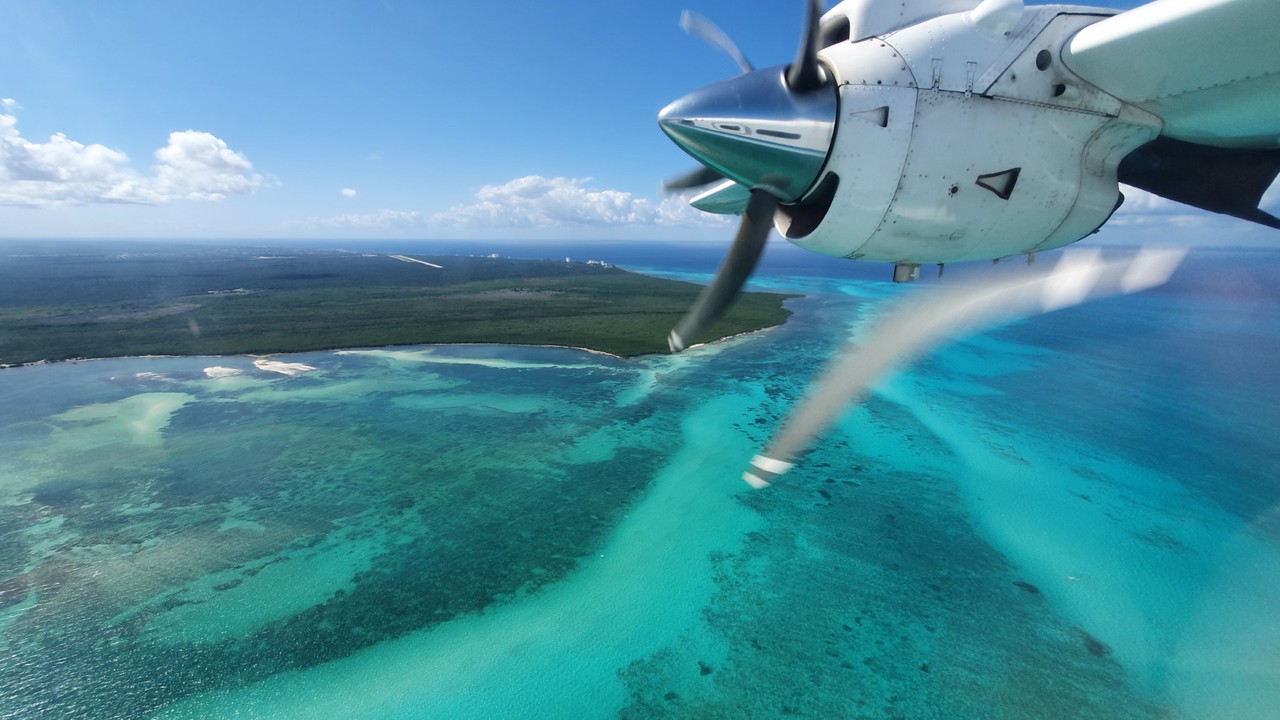

It was all behind us too soon, and the captain turned us due south on approach to runway 29.
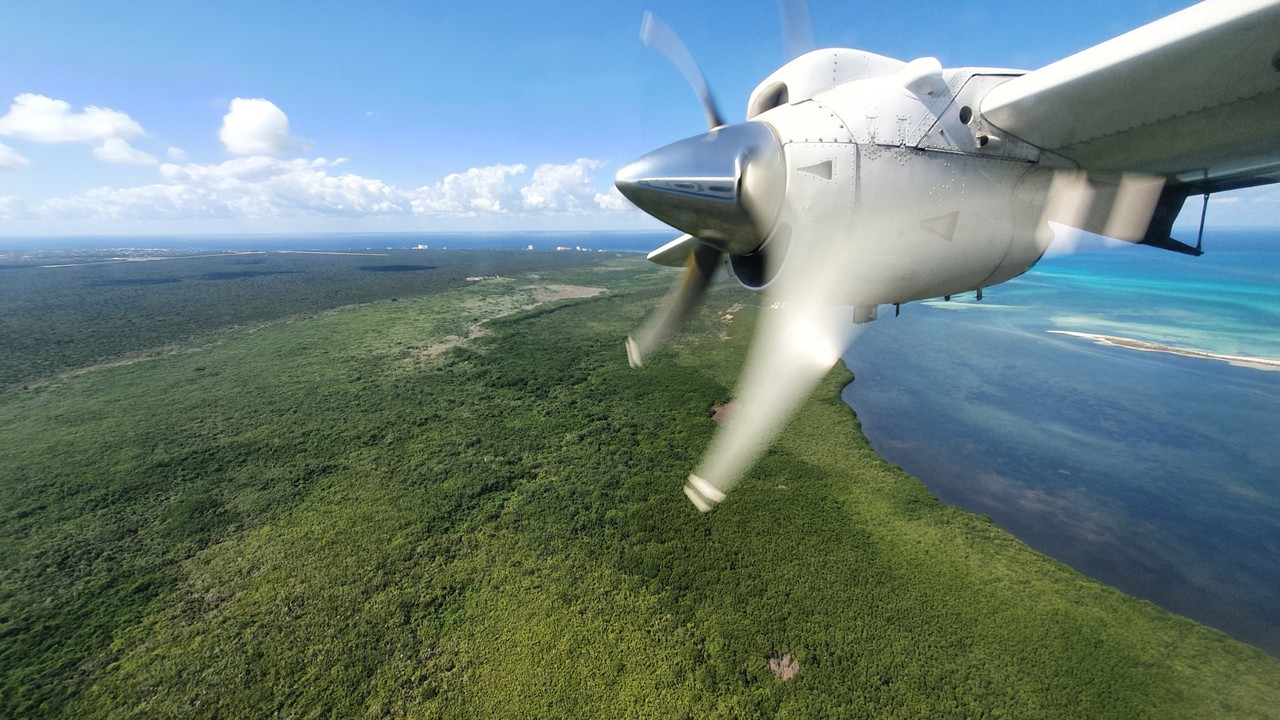
It was a wonderfully gentle glide down over Cozumel's northern point, which remains almost entirely untouched. I was fortunate to be treated to these views, as the bulk of arrivals appeared to use opposite approach during my time on the island. Great for me in the beach bars below, but nowhere near as spectacular for those on board.
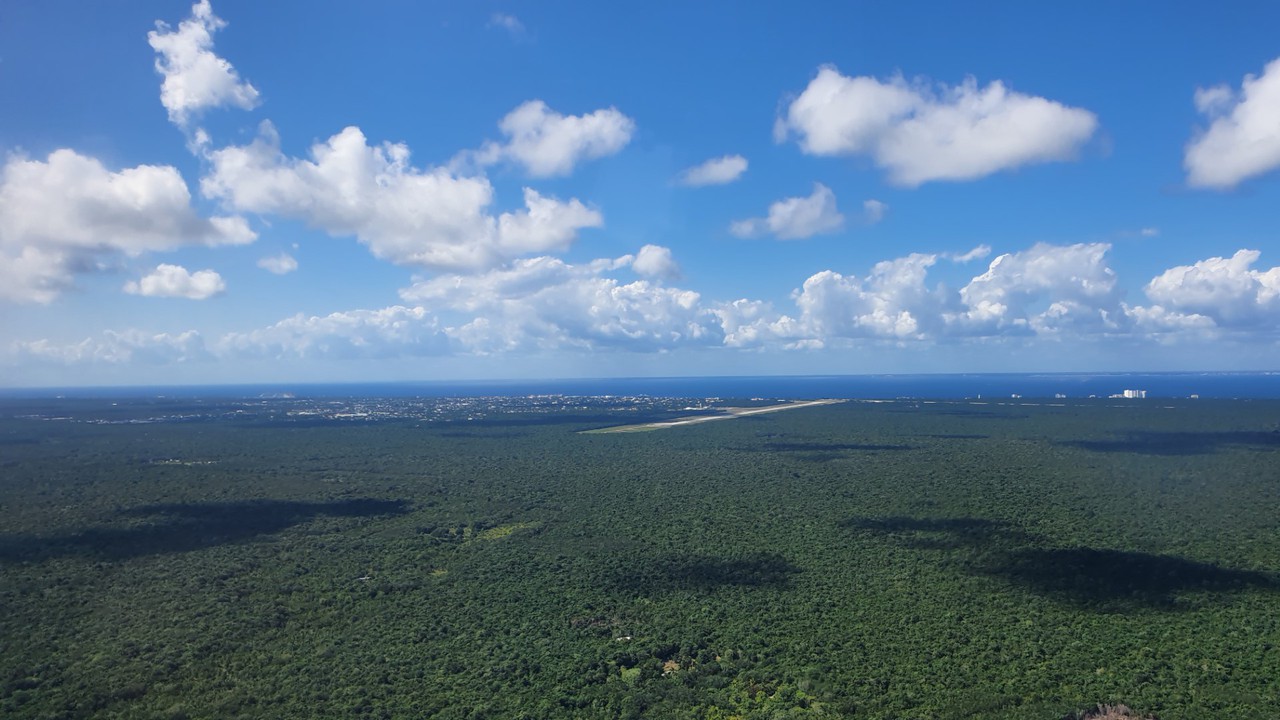
One final turn lined us up with the runway. Looking north from my window, it still felt as if we were drifting down into a swathe of jungle wilderness.

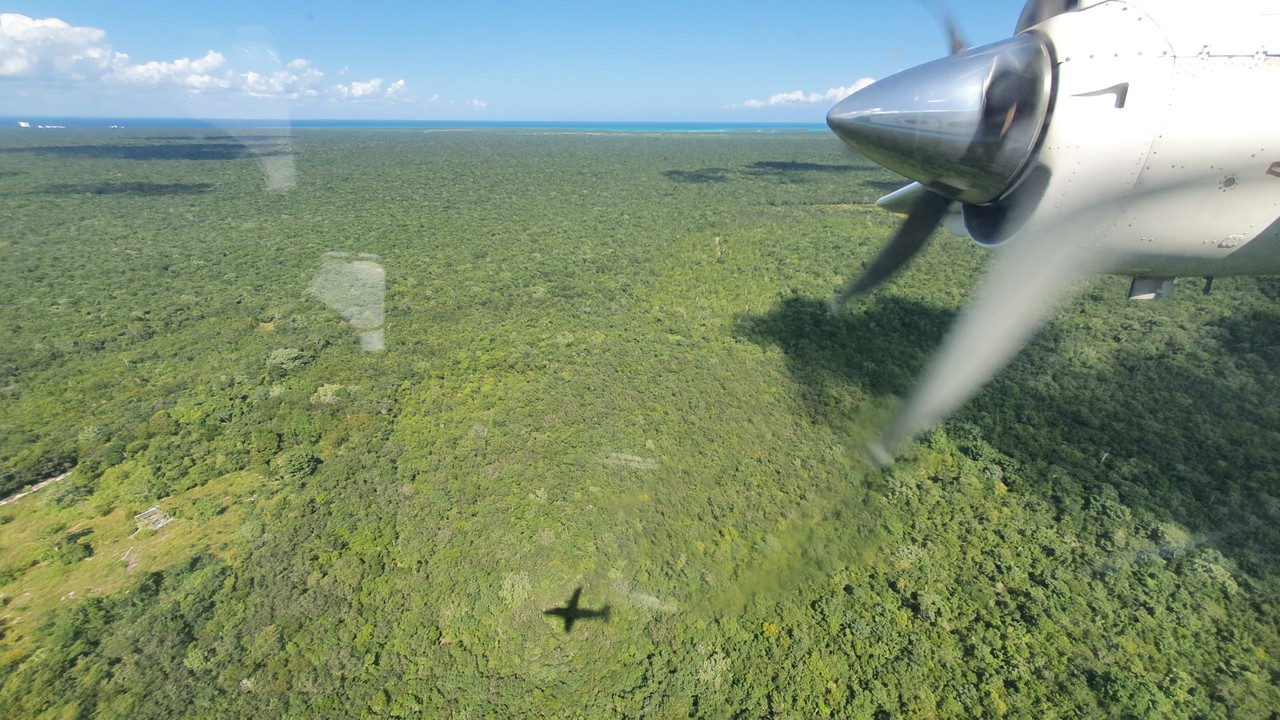
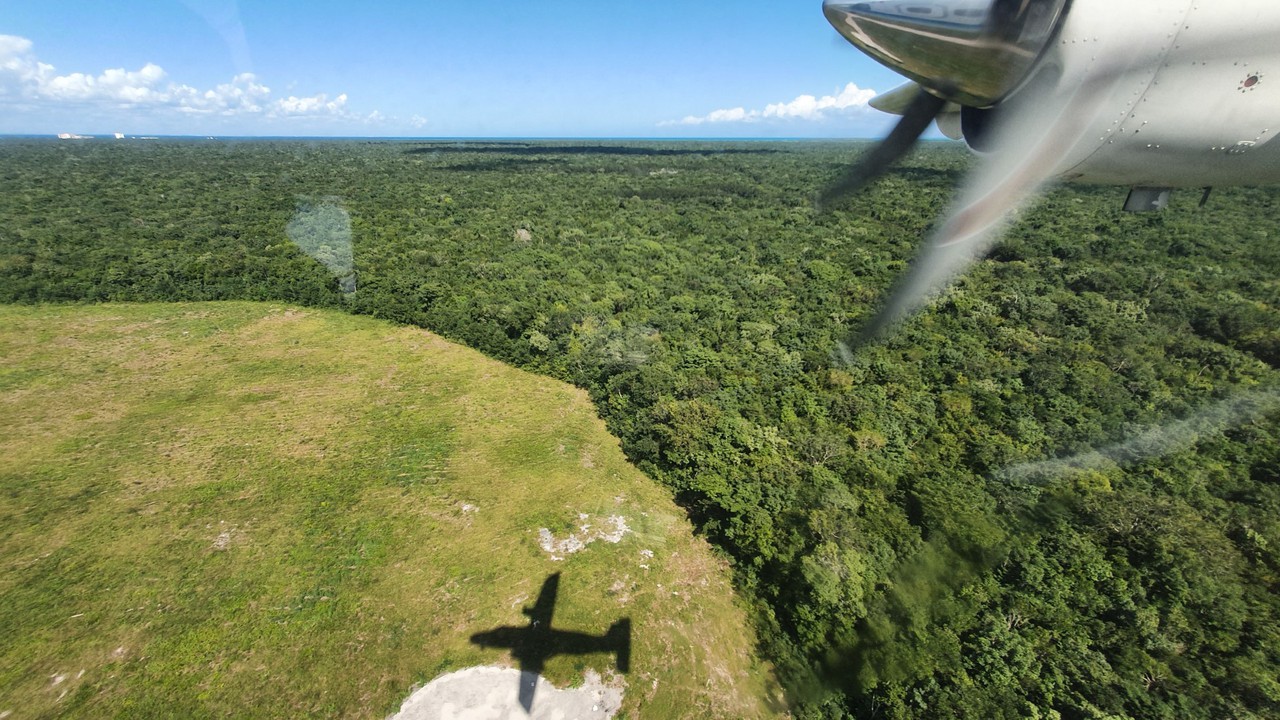
Just 16 minutes after leaving CUN, the flight concluded at 13:27 with a bump and howl from the props.

Technically we were 7 minutes later somehow, but who's counting on Cozumel? It was a seamless taxi onto the apron and to the light/private aircraft stands west of the main terminal. Unsurprisingly, many more of these remote stands were occupied than those at the main terminal.
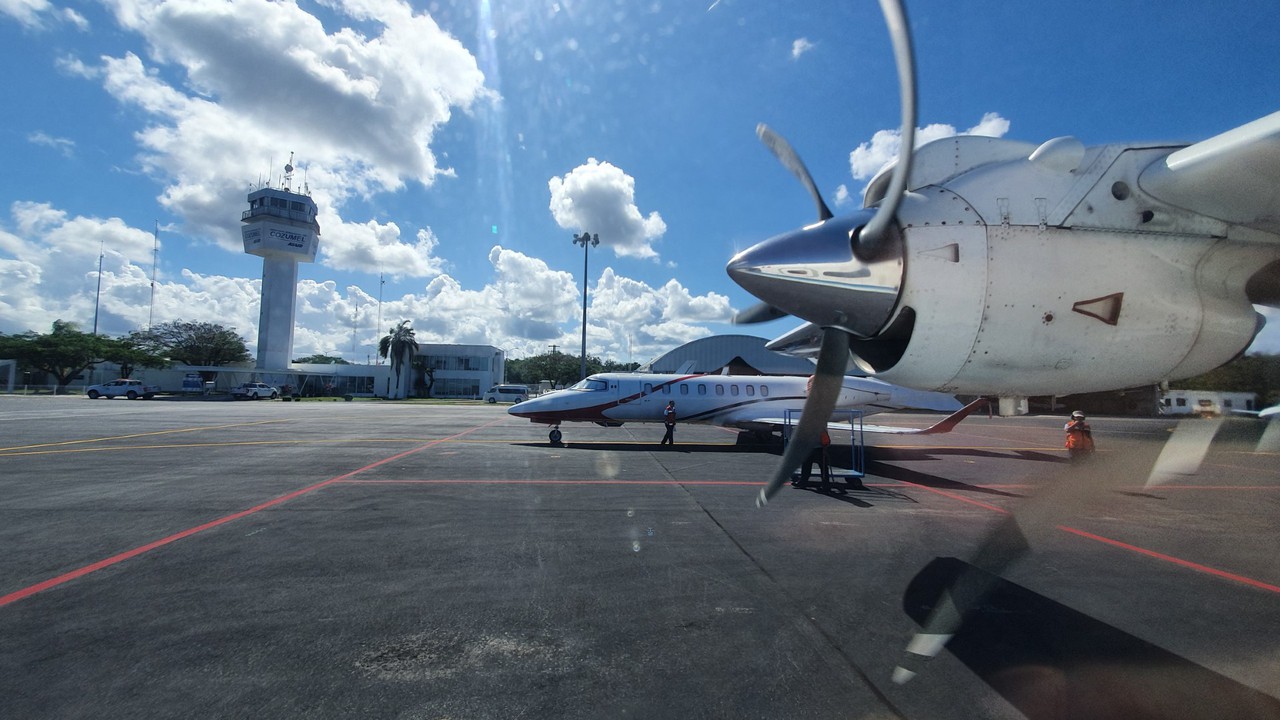
The engines wound down and the rear passenger door was opened in no time. It was over all too soon and time to bid this boxy prop farewell.
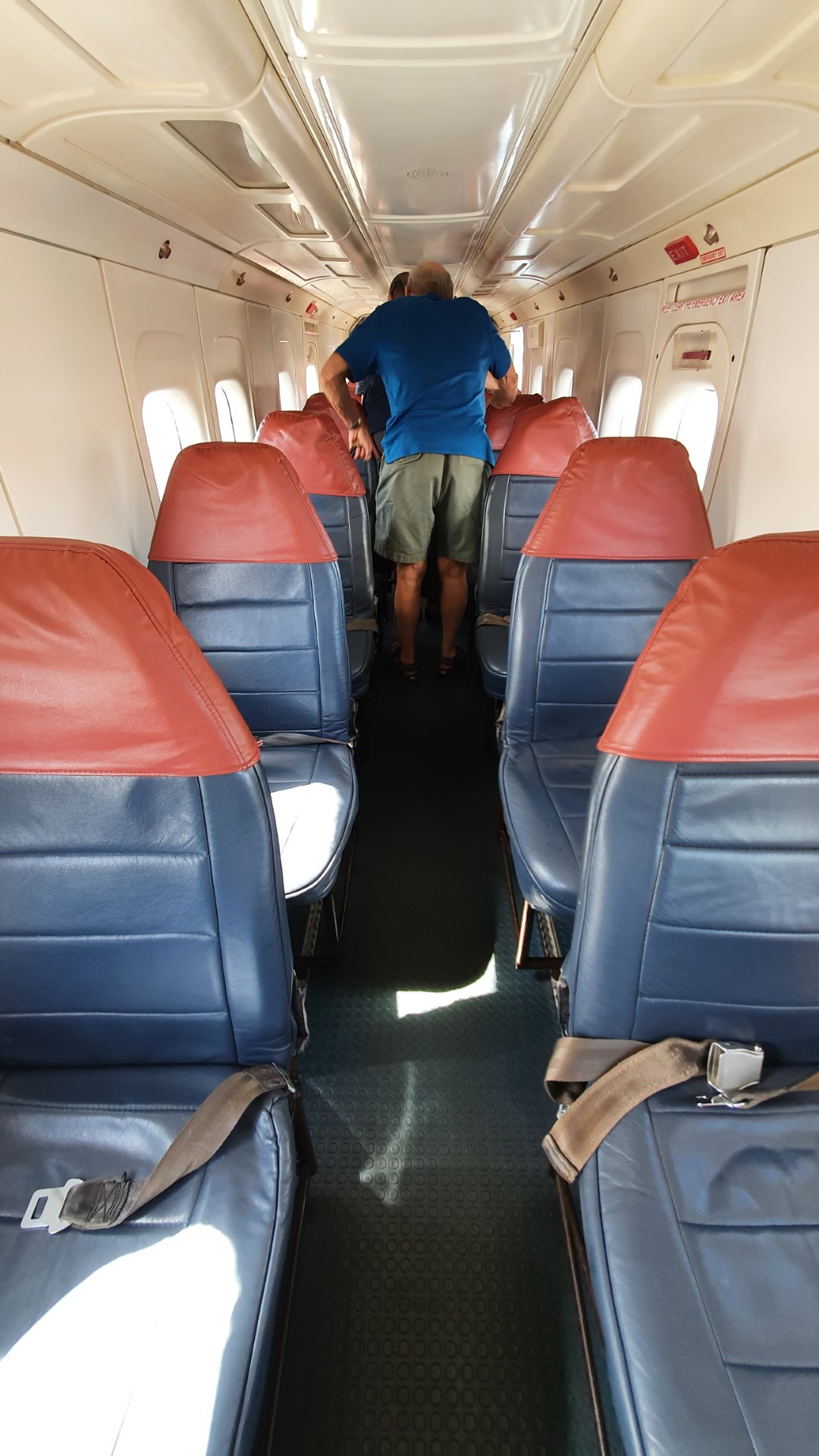
Cozumel International Airport
The captain joined us for the short walking over to baggage reclaim, suggesting that flight was the end of his roster for the day. The only other activity at the airport consisted of two AA flights to DFW and CLT respectively, as well as a UA 737 being pushed back.
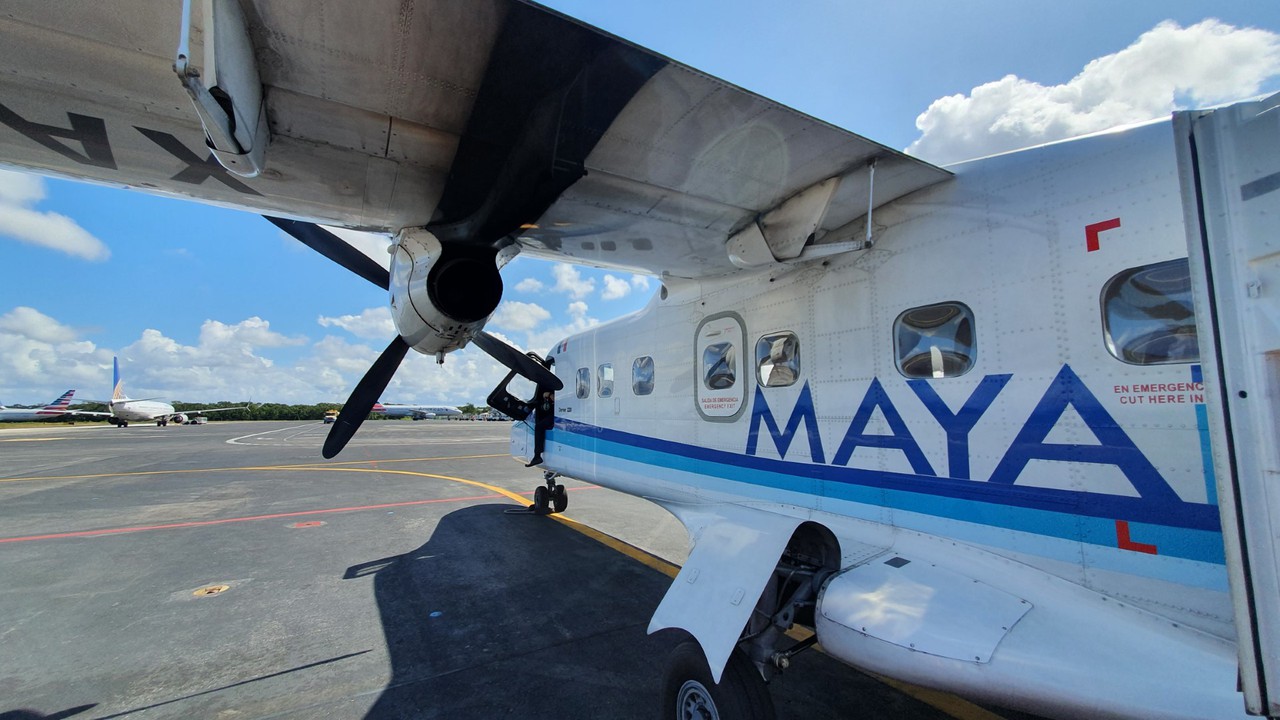
Adios, peqeuño Dornier!

Checked luggage was delivered to the baggage reclaim hall courtesy of an airport employee and trolley straight from the plane's aft hold. With that, I breezed through CZM's arrivals hall and through the swarm of taxi drivers to complete the 15-minute walk into San Miguel to Cozumel (once again, a feat I was told impossible by said taxi drivers!)
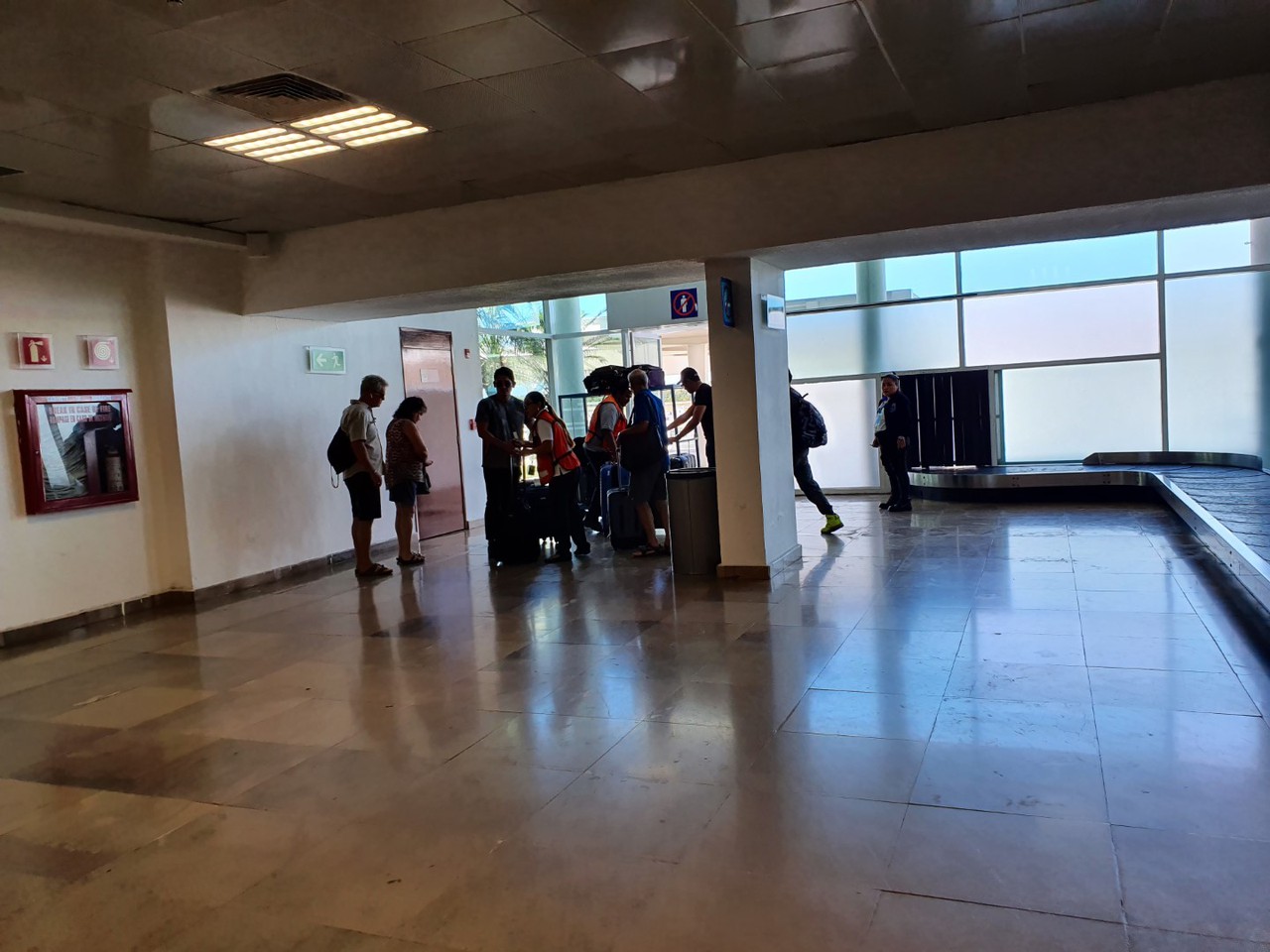

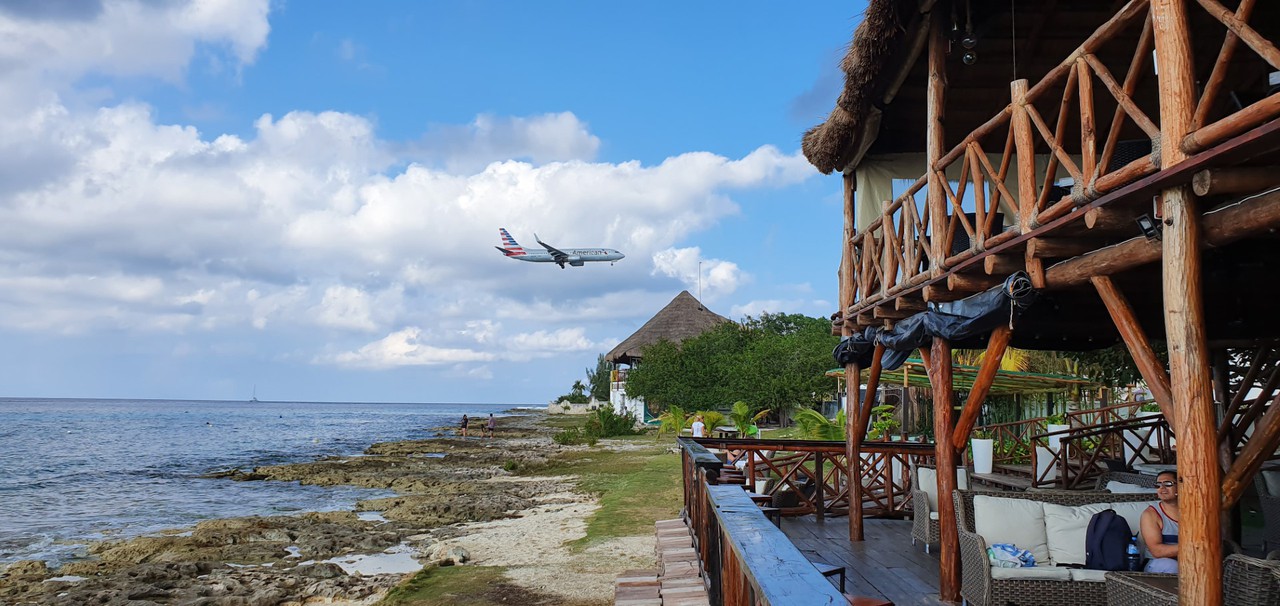
Bonus: Cozumel in pictures

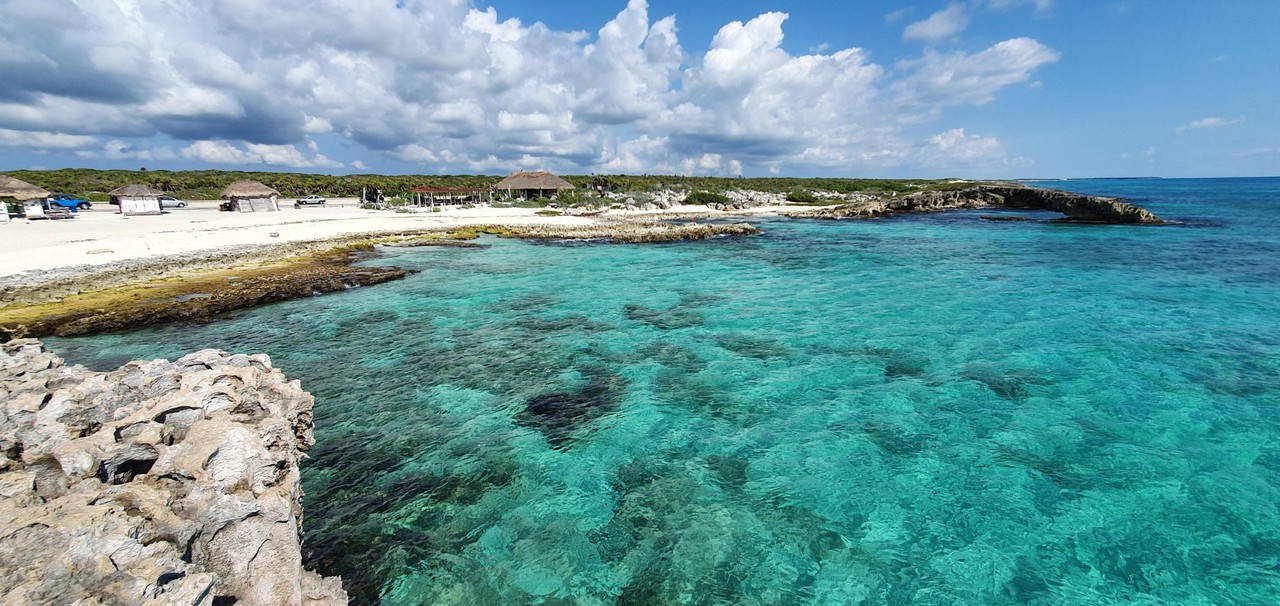
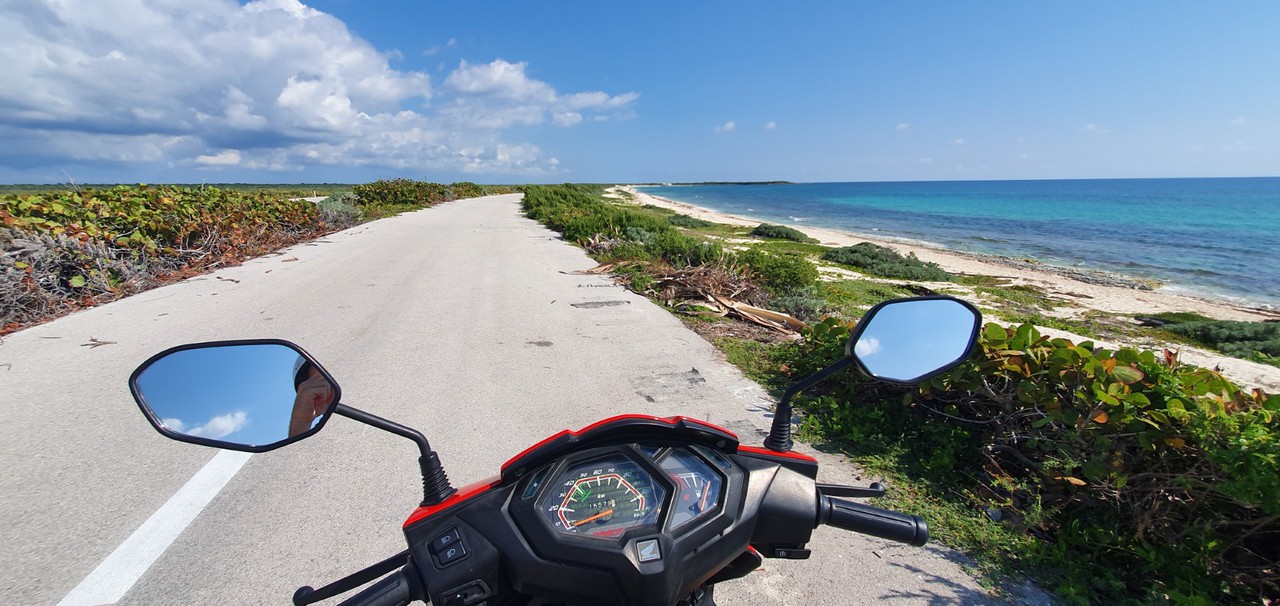


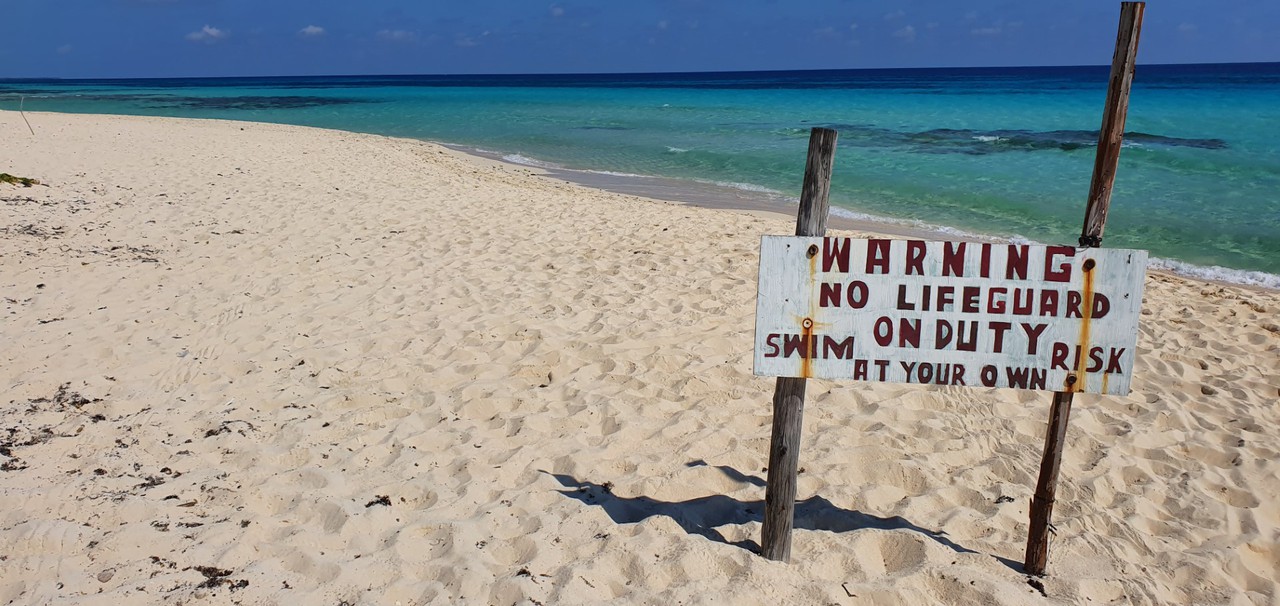


Wow, very cool review! For those amazing views it was definitely worth splurging. Within reason, I would always choose air over sea+road, as would most AvGeeks, I would imagine.
The colour of the water is spectacular! So nice to be able to fantasise about finding tropical paradise again someday after all this is over, haha. For now, thanks for letting us holiday vicariously through your beautiful photos!
Thanks for sharing!
Thanks for your supportive words Kevin! Those blue skies and white beaches sure do feel very far away right now. This is definitely a practical option if getting to Cozumel from CUN (20 mins vs 2-3 hrs) as well as being an avgeek indulgence, so it really was a no-brainer. Who knows, maybe MAYAir will downsize even further and go all-Cessena after this!
The dornier is like a flying fridge if you look from it, but that also means that the cabin is much spacier than most aircraft of it's class like the Metroliner or Beechcraft, but thanks for this exciting report about an airline I never heard of and it does look stunning out there and for only 40 bugs, it is a real bargain.
Thanks for the comment, Thomas! The Do228 is absolutely a box with wings, but ironically more spacious than even some RJs as a result. I saw MAYAir promoting $60 RT fares at their offices during my time there, which is even better value than the bargain I thought I'd gotten! Let's hope their very niche service survives these uncertain times.